Not so long ago, I decided to partially move away from the wonderful world of physics and apply my math and statistics knowledge to no less incredible marketing area. But, a small problem bothered me from the beginning, I had no idea what digital marketing is.
So, I was bombarded with all now-known abbreviations, CPM, CVR, ER, VR, RPL, CPL, CPA, CTR, ROI, ROAS… I felt like my head was going to explode. And just when I thought I have it all figured out, a new metric popped up from the deepest abyss of marketing hell, the abbreviation of which I have to add to the arsenal of the marketing stuff.
I will never forget when my current colleague Dejan opened Google Ads in front of me and starts to ‘explain’ to me what is important. The only thing I remember is, uhm…, nothing 

So, let us roll. As we all know, CTR aka Clickthrough rate is a metric that tells us how well our ad intrigues the selected audience, the ratio of clicks our ad receives divided by the impressions (ad shows) we got, multiplied by 100% to be expressed as a percentage.
Thus, a CTR of 1.40% means that 0.014 of our impressions became clicks, if we had 1,000 impressions, the number of clicks we got is 0.014 * 1,000 = 14
Of course, if you are reading this article, it’s very probable that you already know this. And you surely want to see CTR be as high as possible. And it sounds logical if I get 1,000 impressions I should be happier if my CTR is 3% than in the case when my CTR is 2%, ‘cause I’ll receive 30 instead of 20 clicks for the same number of ad shows!
Mathematically speaking, ideal and constant CTR would be a slope k of the linear function y=kx, where x is the number of impressions, and y is the number of clicks. In the English language, it would be the rate of the increase in the number of clicks with respect to the number of impressions, if the clicks increase linearly with impressions.
Let us draw our example above:

If my goal is to have 20 clicks today, I’ll achieve it faster if my slope (CTR) is 0.03 (3%) or when it is 0.02 (2%). In the first case, I’ll need 20/0.03=667 impressions, in comparison with 20/0.02=1000 impressions. If you think about this, higher CTR really may mean better performance! But… There is always a ‘but’…
Let us see how things are going in the real (for example) video campaign. The data we have is given in the following table:
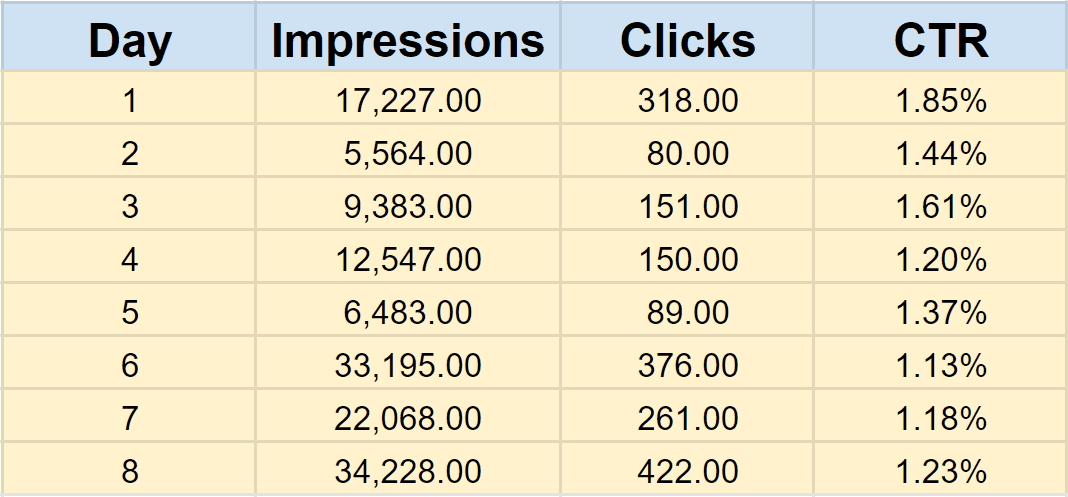
As we can see, we can’t expect a totally stable CTR, and linear increase in clicks, but the fluctuations are not too high to be worried about too much. Daily fluctuations of CTR are something normal, even if the conditions of ad showing are constant, don’t forget that we work with real people, with their daily habits, mood changes, obligations, etc… We can summarize eight days and say that our total CTR is equal to the sum of clicks divides by the sum of impressions, which would give CTR of 1.31%. Mathematically, it means that we would receive the same number of clicks due to the given number of impressions if CTR were 1.31% every day of these eight days.
In cases like this one, it’s helpful to draw a scatterplot graph to visually represent the fluctuations in daily CTR:
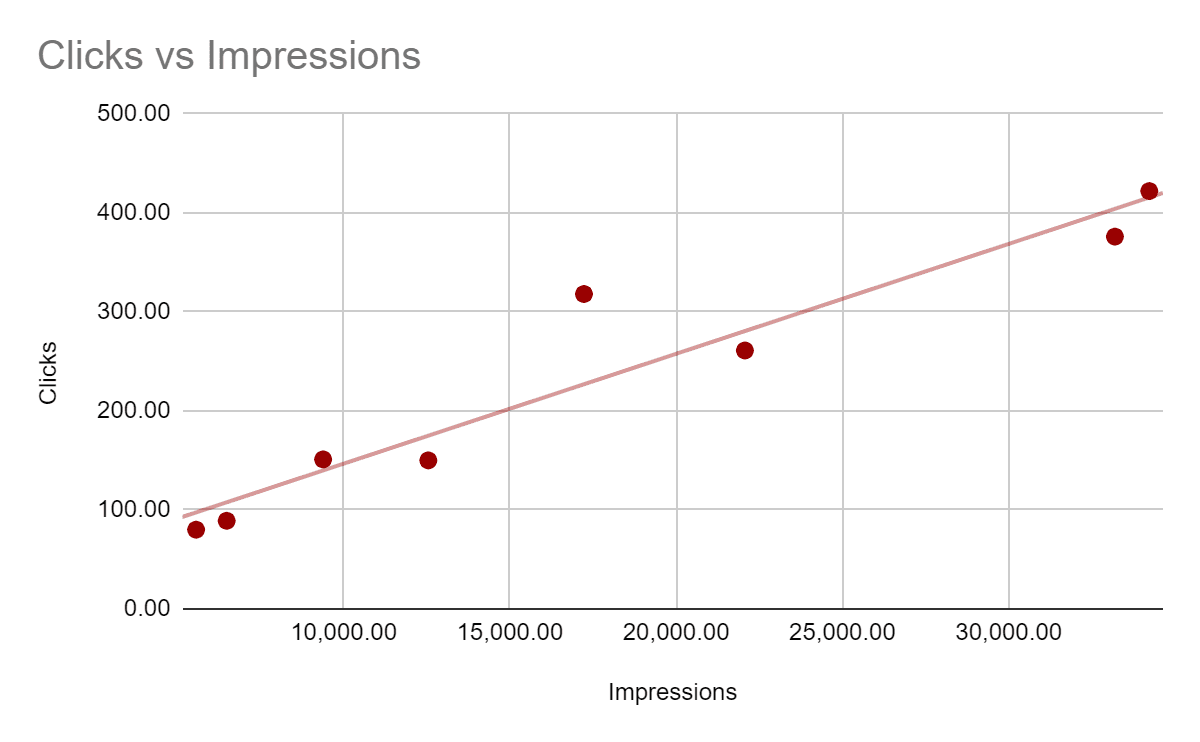
The main conclusion is that dots that represent pairs (impressions, clicks) almost lie on the trendline with a slope which is some kind of average CTR for eight days (not really average, but explaining that is totally another story). Dots above the line are the ones with the highest CTR, and dots below the line are the ones with a lower CTR than the ‘average’ value.
Thus, daily fluctuations are not too high, and if you are ‘obsessed’ with CTR as a performance metric, you can sleep peacefully. The campaign goes on for another eight days, and we have results:
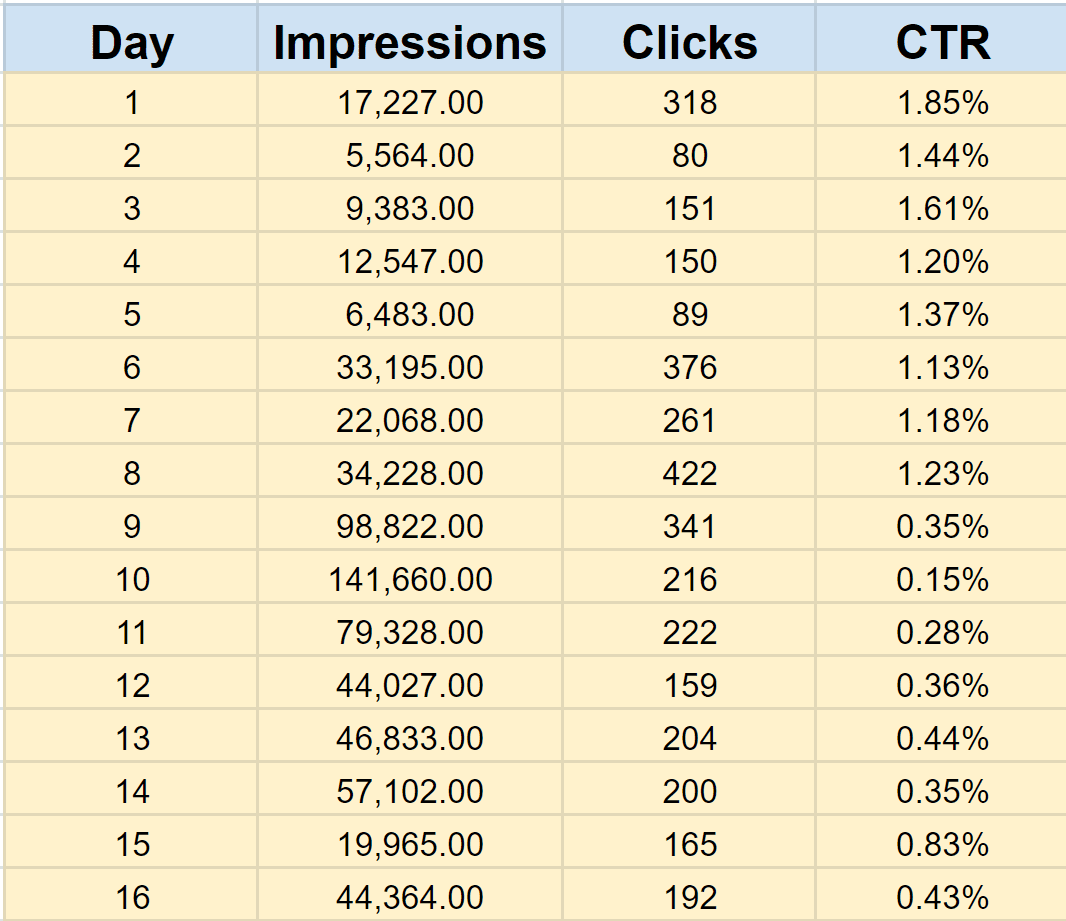
At the first sight, It seems like a catastrophe! CTR dropped significantly and our first instinct is to panic! Scatterplot seems a bit different now:

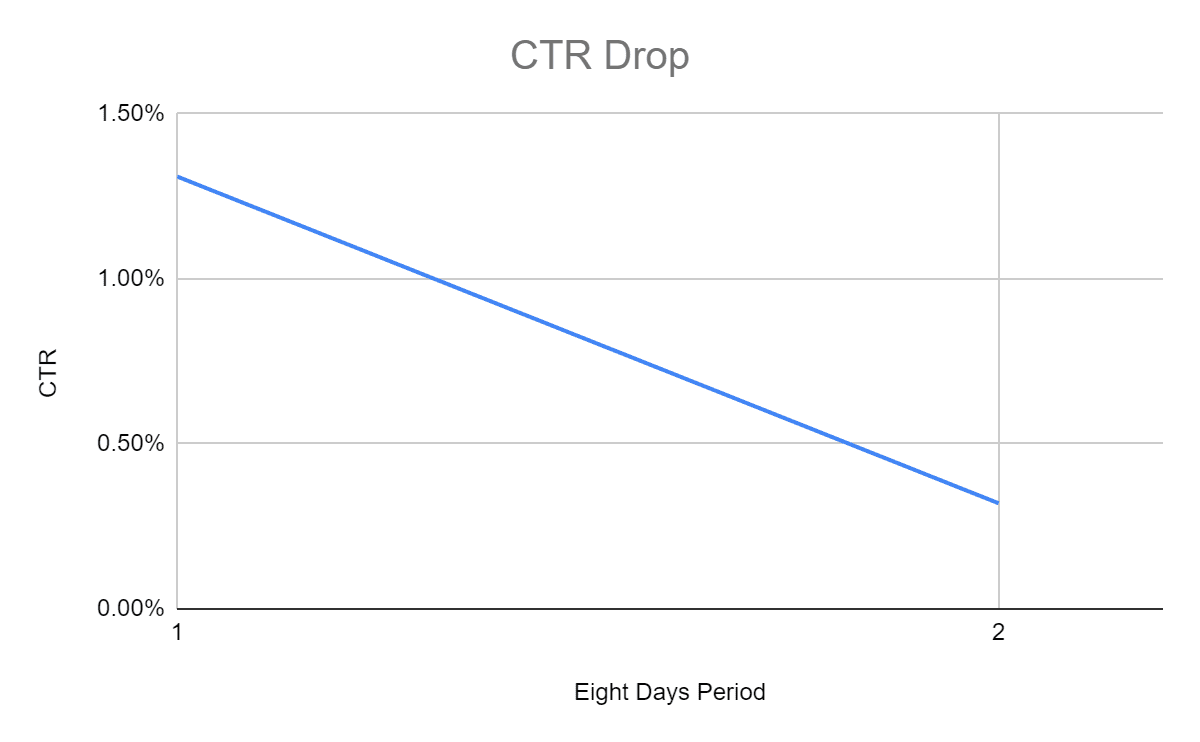
Every sense of order disappeared, it’s not likely to draw any line of trend through these dots! Obviously, something changed and caused a significant drop in daily CTR values (only 0.32% in total). But, we haven’t answered yet: Is it a threat to our campaign’s performance?
This is where we come to the most important part of this article: Looking at CTR without the other metrics is completely meaningless. To be honest, the most important metric to us is SPEND, denoted as Cost in Google Ads, and every time we speak about impressions, interactions, views, clicks, or anything else, it’s necessary to include Cost somehow.
When CTR is the topic, we actually speak about Impressions and Clicks, and if we want to include Cost, we can do it through the easily derived formula, which says:
CPM = CTR * CPC * 1,000
For the novices between the readers, CPM aka Cost per Mille is the amount you have to pay to get 1,000 impressions, while CPC aka Cost per Click is the amount you have to pay for one click! Mathematics is an exact science, the formula above clearly says the relationships between Cost, Impressions, and Clicks have to be adjusted so that they satisfy the formula.
Hence, every time we see such a drop in CTR, it’s very probable that we will notice a significant CPM drop too (unless CPC increases exactly by the same factor CTR decreased). On the other hand, a significant drop in CPM means that we got cheaper impressions (on average!), thus, we can buy more with the same amount of money. If those impressions are the ones of ‘less quality’, their chances to become clicks are reduced, so, we notice CPM and CTR drops followed by each other.
Let us see what the tabular overview looks like:

One look is enough, it’s not some natural law or rule that must be obeyed, but the general tendency is clear. It’s even more clear if we visualize the data:

According to the derived formula, CPC can be expressed as 0.001 multiplied by the ratio of CPM and CTR. The plot tells us more, CPC is relatively stable, despite extreme changes in CPM and CTR, and its range is relatively narrow (min:$3.09, max:$6.53), especially in comparison with the CPM range (min:$8.07, max:$93.83).
Thus, there is no reason to think that your campaign is underperforming in clicks when you see an extreme CTR drop. On the contrary, maybe you’ve got more clicks for the same money than when your CTR has high values since it’s not impossible to have a lower CPC with a CTR drop at the same time. Let us use, for example, data for Day 5 (CTR is 1.37%) and Day 9 (CTR is 0.35%). On Day 5, you needed 1/0.0137=73 impressions to get one click, and on Day 9 you needed 286 impressions to get one click. But, if your Cost for both days was around $1,000 per day, you would achieve 1,000/5.72=175 clicks on Day 5 compared to 1,000/3.37=297 clicks on Day 9.
A similar analysis is applicable to the View rate, and maybe it’s more important because in video campaigns we must pay more attention to views than to clicks, since the view which leads to conversion without click counts as a score for us, don’t forget!
But, what are the reasons for such drops in CPM and CTR, while Campaign settings remain unchanged? Audience segments are the same, you didn’t change geo settings or device settings, so why it happened? The answer, as always, can’t be unique. But one of the possible reasons is described in the following subtitle:
CAMPAIGNS → CONTENT → WHERE ADS SHOWED
We, video advertisers must be aware of one thing - Google charges us for impressions! You will be charged for views ONLY if you choose CPV bidding, but it’s not recommended to choose if your goal is to drive conversions. Thus, the placements of your ad will be the one of factors that determine the amount you must pay each time your ad is shown. Of course, you’ll know only about average values. Let’s see if there is anything that led to CPM and CTR drops.
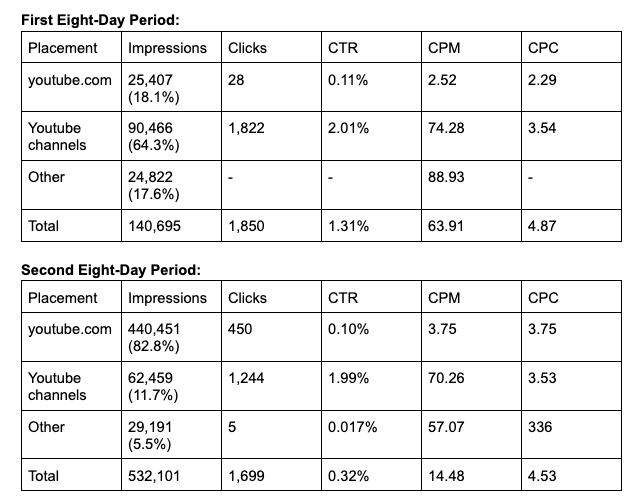
I didn’t say it before, ROAS for both of the eight-day periods analyzed in this article is IDENTICAL! Hence, nothing changed in the metric which is the most important to me, but I need to understand what happened with my traffic, maybe to try to improve the performance, or, at least, to prove that integral CTR doesn’t mean anything.
Let me begin! For those who don’t know about this yet, ‘youtube.com’ represents filtered ‘display’ performance, or better said, in-feed impressions of your ad. Youtube channels are our in-stream impressions, while we don’t know anything about ‘Other’. Anyway, those are the placements of our ad without any success (mostly). As you can see, ‘Other’ has a catastrophically bad performance, with almost no (or literally NONE) views or clicks, and google doesn’t provide the data to us, so don’t fantasize that you can exclude ‘Other’ in the future. But don’t forget, you pay for ‘Other’, the same as you must pay for the other two segments. And, as I said, we don’t know what ‘Other’ really is.
I hope you notice what’s the problem here. You look at the CTR on an account level, or on the campaign level, and what information you’ve got? Almost nothing useful! You don’t know if your performance really dropped, or simply, most of your traffic just went to in-feed or, in the worst-case scenario, the percentage of impressions in the ‘Other’ segment increased.
At least, you must select and clean your data by placement, and see what’s happening, then, you can estimate if your CTR really went down because your ad wasn’t interesting to the potential leads, or if the placement change was in the game.
Anyway, let us summarize: CTR means nothing without other metrics, if it is your main performance indicator, don’t forget to check the others among them. If you are using smart bidding, google is searching for the best solutions due to your bid, CTR is just an incidental metric that you have insight into. It CAN, but not necessarily, be a good performance indicator, but at the end of the day, you’ll pay for impressions. Hence, go to CAMPAIGNS → CONTENT → WHERE ADS SHOWED, and see what you have to pay. Also, compare your daily CPM, CTR, and CPC combinations to quickly get an impression of your performance, here is a tabular review of possible CTR/CPM/CPC relations (a and b are some random real numbers):


So here it is. My two cents, of course, but I truly hope it will help you to analyze some of your performance metrics slightly better, the more data you have, the more noise and wrong conclusions are lurking in the shadows.
Until the next time, high CTR to everyone!
Dobroslav Slijepcevic
- Today's post is brought to you by-
Are you spending over $1k/day on ads and looking to scale your business with YouTube ads?
Schedule your free YouTube strategy call here: 
What are your YouTube ad questions?
In the meantime, what questions do YOU have about YouTube ads?
Let us know in the Comments section below, and we’ll make sure to cover your question in an upcoming post.
Have a nice day!
The VidTao Team
Sign up for VidTao.com: The Free Tool to Discover & Track Your Market's Best YouTube Ads.
Are you spending over $1k/day on paid traffic and want to scale with YouTube ads? Schedule your free YouTube ad brainstorming call here: inceptly.com/call
VidTao.com is brought to you by Inceptly.com - High Performance YouTube Ad Creative & Media Buying Agency Managing $5M/month+ in YouTube Ad Traffic


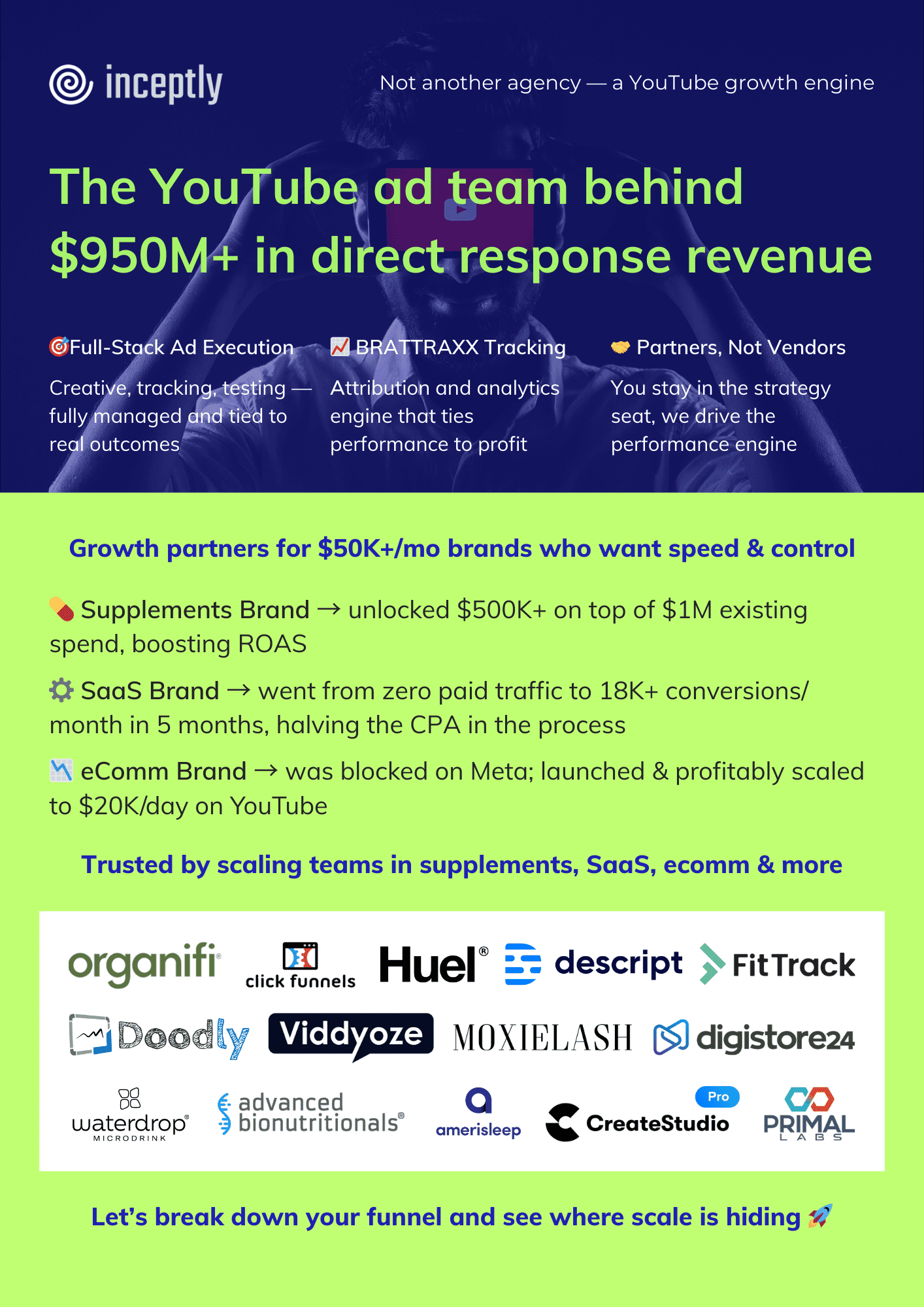
Hello Dobroslav Slijepcevic,
very good and deep analysis.
So what is the conclusion to improve video scripts.
Normally a higher CTR would be good – but it leads to higher costs.
So my consideration is to have a video where the CTR is low and also CPC is low. As this would mean only really low volume (=low CTR) of relevant peoples click.
Would be nice to have a deeper look on this in a further blog – how to adjust metric learning to the script of a video.
Thx Tom
Thanks for reading and nice words, Tom! Low CTR in the case where the number of impressions is enormous, doesn’t mean low volume, on the contrary, there are situations I described in the article when low CTR leads to a higher number of clicks. I think you can’t adjust a condition that would be followed with low CPC and CTR, you only can analyze what happens to your campaigns and decide if the performance is really poor, or if something else is the case, as I described.
Great article! Thanks
Thanks!
What is an acceptable average ctr in youtube ads?